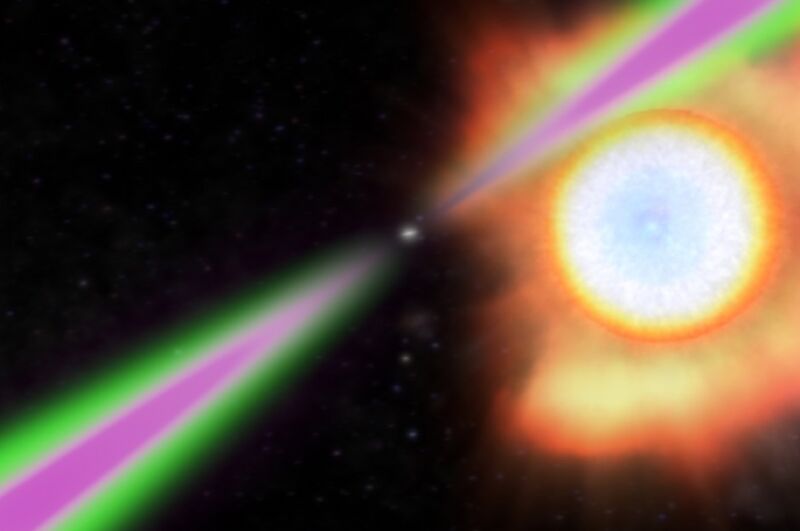“Black widow” neutron star devoured its mate to become heaviest found yet

Enlarge / A spinning neutron star periodically swings its radio (green) and gamma-ray (magenta) beams past Eart. A black widow pulsar heats the facing side of its stellar partner to temperatures twice as hot as the Sun's surface and slowly evaporates it. (credit: NASA's Goddard Space Flight Center)
Astronomers have determined the heaviest neutron star known to date, weighing in at 2.35 solar masses, according to a recent paper published in the Astrophysical Journal Letters. How did it get so large? Most likely by devouring a companion star-the celestial equivalent of a black widow spider devouring its mate. The work helps establish an upper limit on just how large neutron stars can become, with implications for our understanding of the quantum state of the matter at their cores.
Neutron stars are the remnants of supernovae. As Ars Science Editor John Timmer wrote last month:
The matter that forms neutron stars starts out as ionized atoms near the core of a massive star. Once the star's fusion reactions stop producing enough energy to counteract the draw of gravity, this matter contracts, experiencing ever-greater pressures. The crushing force is enough to eliminate the borders between atomic nuclei, creating a giant soup of protons and neutrons. Eventually, even the electrons in the region get forced into many of the protons, converting them to neutrons.
This finally provides a force to push back against the crushing power of gravity. Quantum mechanics prevent neutrons from occupying the same energy state in close proximity, and this prevents the neutrons from getting any closer and so blocks the collapse into a black hole. But it's possible that there's an intermediate state between a blob of neutrons and a black hole, one where the boundaries between neutrons start to break down, resulting in odd combinations of their constituent quarks.
Short of black holes, the cores of neutron stars are the densest known objects in the Universe, and because they are hidden behind an event horizon, they are difficult to study. "We know roughly how matter behaves at nuclear densities, like in the nucleus of a uranium atom," said Alex Filippenko, an astronomer at the University of California, Berkeley and co-author of the new paper. "A neutron star is like one giant nucleus, but when you have 1.5 solar masses of this stuff, which is about 500,000 Earth masses of nuclei all clinging together, it's not at all clear how they will behave."